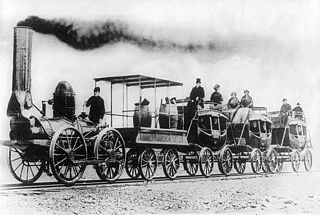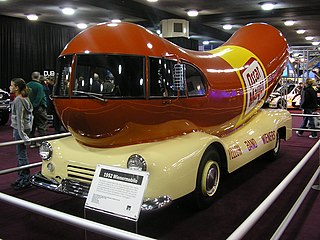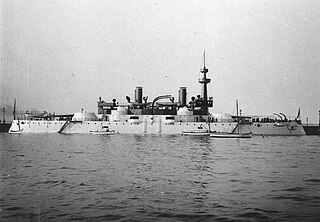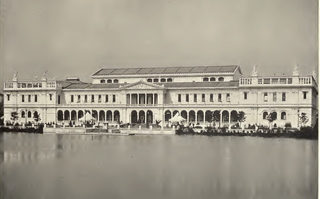
The H. J. Heinz Company was an American food processing company headquartered at One PPG Place in Pittsburgh, Pennsylvania. The company was founded by Henry J. Heinz in 1869. Heinz manufactures thousands of food products in plants on six continents, and markets these products in more than 200 countries and territories. The company claims to have 150 number-one or number-two brands worldwide. Heinz ranked first in ketchup in the US with a market share in excess of 50%; the Ore-Ida label held 46% of the frozen potato sector in 2003.

The World's Columbian Exposition was a world's fair held in Chicago in 1893 to celebrate the 400th anniversary of Christopher Columbus's arrival in the New World in 1492. The centerpiece of the Fair, held in Jackson Park, was a large water pool representing the voyage Columbus took to the New World. Chicago had won the right to host the fair over several other cities, including New York City, Washington, D.C., and St. Louis. The exposition was an influential social and cultural event and had a profound effect on American architecture, the arts, American industrial optimism, and Chicago's image.

The original Ferris Wheel, sometimes also referred to as the Chicago Wheel, was designed and built by George Washington Gale Ferris Jr. as the centerpiece of the Midway at the 1893 World's Columbian Exposition in Chicago, Illinois. Since its construction, many other Ferris wheels have been constructed that were patterned after it.

The DeWitt Clinton of the Mohawk and Hudson Railroad (M&H) was an American steam locomotive and the first working steam locomotive built for service in New York state.
Aunt Jemima was an American breakfast brand for pancake mix, syrup, and other breakfast food products. The original version of the pancake mix was developed in 1888–1889 by the Pearl Milling Company and was advertised as the first "ready-mix" cooking product.

A fleet of motor vehicles shaped like a hot dog on a bun, called "Wienermobile", are used to promote and advertise Oscar Mayer products in the United States. The first Wienermobile was created by Oscar Mayer's nephew, Carl G. Mayer, in 1936.

Heinz 57 is a synecdoche of the historical advertising slogan "57 Varieties" by the H. J. Heinz Company located in Pittsburgh, Pennsylvania, United States. It was developed from the marketing campaign that told consumers about the numerous products available from the Heinz company.

Robert Ferris Prince was an American radio and television sportscaster and commentator, best known for his 28-year stint as the voice of the Pittsburgh Pirates Major League Baseball club, with whom he earned the nickname "The Gunner" and became a cultural icon in Pittsburgh.

A Chicago-style hot dog, Chicago Dog, or Chicago Red Hot is an all-beef frankfurter on a poppy seed bun, originating from the city of Chicago, Illinois. The hot dog is topped with yellow mustard, chopped white onions, bright green sweet pickle relish, a dill pickle spear, tomato slices or wedges, pickled sport peppers, and a dash of celery salt. The complete assembly of a Chicago hot dog is said to be "dragged through the garden" due to the many toppings. The method for cooking the hot dog itself varies depending on the vendor's preference. Most often they are steamed, water-simmered, or less often grilled over charcoal.

The Columbian half dollar is a coin issued by the Bureau of the Mint in 1892 and 1893. The first traditional United States commemorative coin, it was issued both to raise funds for the 1893 World's Columbian Exposition and to mark the quadricentennial of the first voyage to the Americas of Christopher Columbus, whose portrait it bears. The Columbian half dollar was the first American coin to depict a historical person.

Heinz Tomato Ketchup is a brand of ketchup manufactured by the H. J. Heinz Company, a division of the Kraft Heinz Company.

The SS Christopher Columbus was an American excursion liner on the Great Lakes, in service between 1893 and 1933. She was the only whaleback ship ever built for passenger service. The ship was designed by Alexander McDougall, the developer and promoter of the whaleback design.

Illinois was a detailed, full-scale mockup of an Indiana-class coastal defense battleship, constructed as a naval exhibit at the World's Columbian Exposition in Chicago, Illinois, in 1893. It was built alongside a pier of stuccoed brick atop wood pilings, with a stucco covered wood-framed superstructure, and outfitted with limited mechanical systems and displays.

Konig's Westphalian Gin was a Steinhäger gin produced up to the early part of the twentieth century from mineral water at H. C. König's "model distillery" in Steinhagen, Westphalia, Germany, said at the time to be the largest and the oldest gin distillery in the world. The gin was first produced in 1640.

The Woman's Building was designed and built for the World's Columbian Exposition held in Chicago in 1893 under the auspices of the Board of Lady Managers. Of the twelve main buildings for the Exhibition, on June 30, 1892 The Woman's Building was the first to be completed. It had exhibition space as well as an assembly room, a library, and a Hall of Honor. The History of the World's Fair states, "It will be a long time before such an aggregation of woman's work, as may now be seen in the Woman's Building, can be gathered from all parts of the world again."

The Queen Isabella Association was formed to raise funds to provide a statue of Queen Isabella of Spain on the site of the 1893 World's Columbian Exposition in Chicago, Illinois. The group's additional purpose was to advance the cause of women's suffrage and equal rights.
Lydia Purdy Hess was an American artist best known for her Portrait of Miss E. H., which was exhibited at the Paris Salon de la Societé Nationale des Beaux-Arts, the Pennsylvania Academy of Fine Arts, and the World's Columbian Exposition in Chicago in 1893.

The World's Largest Stove was an oversized replica of a kitchen stove that was made for the 1893 Chicago World's Fair as a representation of Michigan Stove Company and its products. After the fair finished, the replica was displayed and used for advertising for decades at the company's headquarters in downtown Detroit. The wooden stove replica eventually deteriorated to a poor state and in 1974 the pieces were stored in a warehouse. In the late 1990s, the replica was restored and given a permanent home at Michigan State Fairgrounds. In 2011 it was destroyed by fire, likely caused by a lightning strike.

The Board of Lady Managers of the World's Columbian Exposition was organized November 19, 1890. It oversaw the construction of The Woman's Building in Chicago and organized the exposition's World's Congress of Representative Women (1893). A cookbook with autographed recipes of board members was also issued.

















